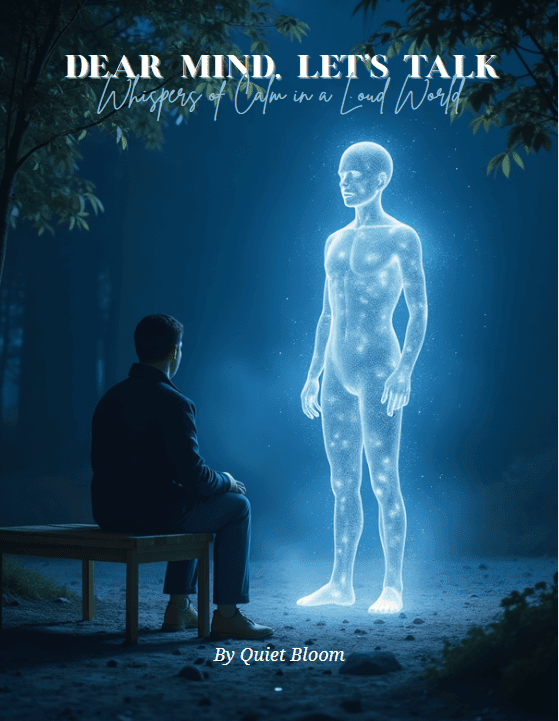ANXIETY : 2 Powerful Tools That Helped Me Break Free From Anxiety
Anxiety can feel like an invisible cage. For years, I lived inside it, with my thoughts racing late into the night, my heart pounding at the smallest trigger, and my mind searching desperately for a way out. I tried to ignore the noise, to push it aside, to pretend I was fine. The more I fought it, the louder it seemed to get.
What finally changed everything was not a miracle cure or a sudden burst of confidence. It was the discovery of two powerful tools, two guides that helped me understand my anxious mind and gently led me toward healing. These were not just books; they became companions on my journey, offering comfort, clarity, and real hope when I needed it most.
In this article, I will share how Dear Mind, Let’s Talk and Dear Mind, I Heard You by Quiet Bloom transformed my relationship with anxiety. You will see how these resources guided me step by step, from the first honest conversation with my mind to the quiet victories of recovery. If you have ever felt trapped by your own thoughts, know that you are not alone. There is a way forward, and sometimes, all it takes is the right conversation to begin.
Let’s start this journey together.
The First Tool: Starting an Honest Conversation With My Mind
or a long time, I believed that my mind was my enemy. Every anxious thought felt like a threat, and every worry seemed to be a sign that something was wrong with me. Everything shifted the day I decided to stop fighting and start listening. Instead of running from my thoughts, I sat down and asked myself a simple question: “Why are you feeling this way?”
That was the beginning of my real journey. I realized that anxiety, as overwhelming as it can be, is often a message. It is my mind’s way of trying to protect me, to keep me safe from pain or disappointment. The trouble starts when I ignore these signals or try to silence them without understanding their source.
This is where Dear Mind, Let’s Talk by Quiet Bloom became my first essential tool. The book is more than just advice. It is an invitation to have a gentle, honest conversation with your own mind. Through its pages, I learned how to approach my thoughts with curiosity instead of fear, and how to uncover the real reasons behind my anxiety.

The process was not easy at first. I had to sit with uncomfortable memories and admit truths I had buried for years. As I continued, I discovered that my mind was not trying to sabotage me. It was asking for attention, for understanding, and for compassion. Each time I paused to listen, the noise inside grew a little quieter.
Dear Mind, Let’s Talk guided me through practical exercises and reflections that helped me identify my anxiety triggers. It encouraged me to write letters to my mind, ask questions, and even thank it for trying to protect me. This simple act of self-dialogue became a turning point. It transformed my relationship with my thoughts and gave me the clarity I needed to move forward.
If you have ever felt overwhelmed by your own mind, know that you are not alone. Sometimes, the first step to healing is simply to listen. Sometimes, all it takes is the right guide to show you how.
The Second Tool: Embracing the Healing Process
After I learned to listen to my mind, I realized that understanding anxiety was only the first step. Healing required something more-a willingness to move forward, even when progress felt slow or uncertain. That is when I discovered my second powerful tool: Dear Mind, I Heard You by Quiet Bloom.

This book became a gentle guide through the ups and downs of recovery. It showed me that healing from anxiety is not about erasing difficult feelings, but about learning to live with them, to honor them, and to trust that calm is possible, even on the hardest days. The process was not linear. Some days, I felt strong and hopeful. Other days, old fears resurfaced, and I doubted my progress. What made the difference was having a roadmap, a set of practical steps and words of encouragement that reminded me healing is a journey, not a destination.
Dear Mind, I Heard You offered validation and support at every stage. It encouraged me to celebrate small victories, to be patient with setbacks, and to practice self-compassion. Through its exercises and reflections, I learned to recognize my progress, no matter how gradual it seemed. The book helped me see that every effort to care for my mind was an act of courage.
If you are on your own path to healing, remember that you do not have to do it alone. With the right tools and a little kindness toward yourself, you can find your way out of anxiety’s shadow. Sometimes, the most powerful change begins with the simple act of saying, “I hear you.”
How These Two Tools Work Together
Looking back, I see that each of these books offered something unique, yet they complemented each other perfectly. Dear Mind, Let’s Talk helped me break the silence and start a compassionate conversation with my own thoughts. It gave me the courage to ask questions and to listen, even when the answers were difficult. This was the foundation I needed to understand where my anxiety came from.
Dear Mind, I Heard You then showed me how to take the next step. It guided me through the process of healing, teaching me to accept my feelings and to celebrate progress, no matter how small. With its support, I learned to be patient with myself and to trust that healing is possible, even if it takes time.
When used together, these two tools become more than just books. They are like having a wise friend by your side, someone who understands what you are going through and knows how to help you move forward. They remind you that your mind is not your enemy and that you have the strength to find calm, even when life feels overwhelming.
If you are searching for a way to understand your anxiety and begin healing, these guides can be your companions too. They do not promise instant results, but they offer something more valuable: understanding, encouragement, and hope for real change. Sometimes, the most powerful tools are the ones that help you listen to yourself and believe that you can find your way out.
Visual Companions on the Journey
To make this journey even more tangible, I want to share the covers of the two books that guided me. Each image captures the essence of what these guides represent: a meeting between your everyday self and the luminous, understanding part of your mind that is always waiting to be heard.
![Cover of Dear Mind, Let’s Talk by Quiet Bloom, showing a person sitting on a bench facing a luminous, human-shaped figure in a tranquil forest at night.]
Dear Mind, Let’s Talk invites you to sit quietly with your thoughts and begin an honest conversation. The calm, blue forest setting reflects the gentle, introspective nature of the book—a safe space to explore your inner world.
![Cover of Dear Mind, I Heard You by Quiet Bloom, featuring a person seated on a chair facing a glowing, human-shaped figure in a sunlit forest path.]
Dear Mind, I Heard You symbolizes the next step: embracing healing and growth. The warm, golden light and open path evoke hope, progress, and the promise that you can move forward, even when the way is uncertain.
These visual companions are more than just book covers. They are reminders that your journey with anxiety is valid, that understanding and healing are possible, and that you have the strength to face your mind with compassion and courage.
About the Author
Hi, it’s me, just a fellow human who knows what it feels like to overthink a single moment for hours, to lie awake at night with a racing mind, and to want so badly to feel normal, calm, and confident.
I’ve spent years learning about the mind, emotional resilience, and what truly helps when the noise inside gets loud. What I share here isn’t just theory, it’s a mix of lived experience, real understanding, and gentle guidance I’ve seen help time and time again.
This book was born not from a place of perfection, but from lived moments, the quiet ones, the hard ones, the healing ones. I’ve written these pages the way I wish someone would have spoken to me when I needed it most: softly, honestly, like a friend who gets it.
I believe in the kind of strength that whispers, not shouts. The kind of healing that happens slowly, in the small spaces no one else can see. And I believe, deeply, that your story matters. That your mind, no matter how loud or anxious it gets, is not your enemy. It just wants to be heard.
If these words have kept you company in any way, I’m truly grateful. You are not alone in this.
And if you ever forget that, come back to these pages. Let them remind you.
With warmth always,
– Quiet Bloom
Practical Strategies That Supported My Recovery
While the books Dear Mind, Let’s Talk and Dear Mind, I Heard You were the foundation of my healing, I also discovered that real progress came from combining their guidance with practical, everyday habits. Recovery from anxiety is rarely about a single solution. It is more like assembling a puzzle, where each small piece helps to complete the bigger picture.
Here are some of the most effective strategies that supported my journey, inspired by both the books and expert recommendations:
- Journaling and Self-Reflection: Writing down my thoughts helped me untangle the knots in my mind. By putting worries on paper, I could see patterns and triggers more clearly. This practice, encouraged in both books, made my inner dialogue more honest and less overwhelming.
- Mindfulness and Breathing Techniques: Simple grounding exercises, like focusing on my breath or noticing the details around me, helped calm my nervous system. These moments of mindfulness made it easier to respond to anxiety with patience instead of panic.
Physical Activity: Regular walks or gentle exercise gave my body a healthy outlet for stress. Movement helped release tension and improved my mood, even on the toughest days.
Healthy Routines: Getting enough sleep, eating balanced meals, and limiting caffeine all played a role in stabilizing my emotions. Small changes in daily habits often made a big difference in how I felt overall.
Seeking Support: Talking with a trusted friend or mental health professional provided reassurance and perspective. Sometimes, just knowing I was not alone made the burden feel lighter.
- Celebrating Small Wins: Both books taught me to recognize and appreciate progress, no matter how minor it seemed. Each step forward, even if it was just getting out of bed or facing a small fear, deserved acknowledgment.
It is important to remember that recovery is a gradual process. There will be setbacks and days when anxiety feels stronger, but persistence and self-compassion are key.
No single technique works for everyone, so it is worth exploring different approaches to find what fits your needs.
If you are struggling with anxiety, know that combining practical strategies with compassionate self-dialogue can create real change. Healing is possible, and every effort you make is a step toward a calmer, more resilient mind.
Additional Resources and When to Seek Help
While self-help tools and personal strategies can make a significant difference, it is important to recognize when professional support is needed. Anxiety can sometimes become overwhelming, persistent, or interfere with daily life in ways that require more than self-guided recovery. If you ever feel stuck, hopeless, or unable to manage your symptoms alone, reaching out to a mental health professional is a strong and courageous step.
Therapies like cognitive behavioral therapy, acceptance and commitment therapy, or talk therapy have been shown to help many people understand and manage anxiety more effectively. For some, medication, prescribed and monitored by a healthcare provider, can also play a role in making symptoms more manageable, especially when combined with therapy or lifestyle changes.
The right approach is different for everyone, and it may take time to find what works best for you.
Alongside professional care, building resilience through regular exercise, mindfulness, healthy routines, and supportive relationships can help reduce the impact of anxiety over time.
Remember, seeking help is not a sign of weakness. It is a proactive choice for your well-being.
If you are supporting someone with anxiety, simply being present, listening without judgment, and encouraging them to seek help when needed can make a profound difference.
Your journey is unique, and healing is possible. Whether you start with self-guided tools like Dear Mind, Let’s Talk and Dear Mind, I Heard You, or seek additional support, every step you take is a step toward greater calm and confidence. You are not alone, and there are many paths forward.
Getting Meaningful Goals for Lasting Anxiety Recovery
One of the most important lessons I learned on this journey is that healing from anxiety is not just about coping in the moment. It is about setting clear, meaningful goals that keep you moving forward, even when progress feels slow. The right goals give structure to your recovery, help you measure your growth, and remind you that every small step counts
Why Goals Matter
When anxiety feels overwhelming, it is easy to lose sight of progress. Setting specific goals—like improving sleep quality, reducing the frequency of panic attacks, or facing situations you have been avoiding—gives you something concrete to work toward. These goals are not just about reducing symptoms. They are about reclaiming your life and building confidence in your ability to handle whatever comes your way
.
How to Set Effective Goals
The most effective goals are:
- Specific: Define exactly what you want to achieve. For example, “I want to attend a social event without leaving early because of anxiety.”
- Measurable: Decide how you will track your progress. This could be the number of anxiety episodes per week or how long you can stay calm in a challenging situation.
- Achievable: Start with goals that feel realistic for you right now. Small wins build momentum.
- Relevant: Focus on changes that will make a real difference in your daily life.
- Time-bound: Give yourself a gentle deadline, like “within the next month” or “by the end of the year”.
Examples of Recovery Goals
Here are some goals that many people find helpful:
- Reduce the frequency and intensity of panic attacks over the next two months.
- Sleep through the night without anxiety-related waking at least five nights a week.
- Gradually face situations you have been avoiding, such as social gatherings or public speaking.
- Lower the intensity of physical anxiety symptoms, like a racing heart or muscle tension, by practicing daily relaxation techniques.
- Develop a personal crisis response plan for moments when anxiety spikes, so you feel more in control.
Combining Goals With Support
You do not have to do this alone. Sharing your goals with a trusted friend, therapist, or support group can make them feel more achievable and less intimidating. Professional therapies like cognitive behavioral therapy (CBT) and acceptance and commitment therapy (ACT) are proven to help people identify, refine, and reach their anxiety recovery goals.
These approaches teach practical skills for changing thought patterns, facing fears, and building resilience over time.
Celebrate Every Step
No matter how small, every bit of progress is worth celebrating. Healing from anxiety is a journey with ups and downs, but each goal you reach is proof that change is possible. Be kind to yourself, adjust your goals as needed, and remember that every effort counts.
You are building a new relationship with your mind, one grounded in understanding, hope, and the belief that you can create a calmer, more confident life.
Find additional strategies and real-life tips in our article: How to Get Rid of Anxiety.
Frequently Asked Questions About Anxiety and Recovery
1. Can anxiety really go away, or will I always have to deal with it?
Anxiety can be managed very effectively, and many people experience significant improvement with the right tools, support, and sometimes professional help. For some, anxiety may disappear completely; for others, it becomes much easier to handle in daily life.
2. What are the most effective self-help strategies for anxiety?
Some of the best self-help strategies include cognitive behavioral therapy (CBT), mindfulness, regular physical activity, maintaining a healthy routine, and reflective journaling. Books like Dear Mind, Let’s Talk and Dear Mind, I Heard You can also guide you in starting an inner dialogue and moving toward healing.
3. When should I seek professional help for anxiety?
If anxiety becomes overwhelming, prevents you from functioning normally, or causes significant distress despite your efforts, it is important to consult a mental health professional. Speaking with a therapist or doctor can provide tailored solutions for your situation.
4. Is it normal to have setbacks during recovery?
Yes, setbacks or periods of doubt are a natural part of the healing process. The key is to be gentle with yourself and to continue using the tools and strategies that help you. Every step, even the difficult ones, is part of the journey toward greater calm and confidence.
5. Where can I find more resources on overcoming anxiety?
You can read our detailed guide here: How to Get Rid of Anxiety, or explore professional resources and support groups both online and in your local community.


Ping : 7 Signs of Remote Work Burnout & How to Reclaim Your Peace - Scriptobits